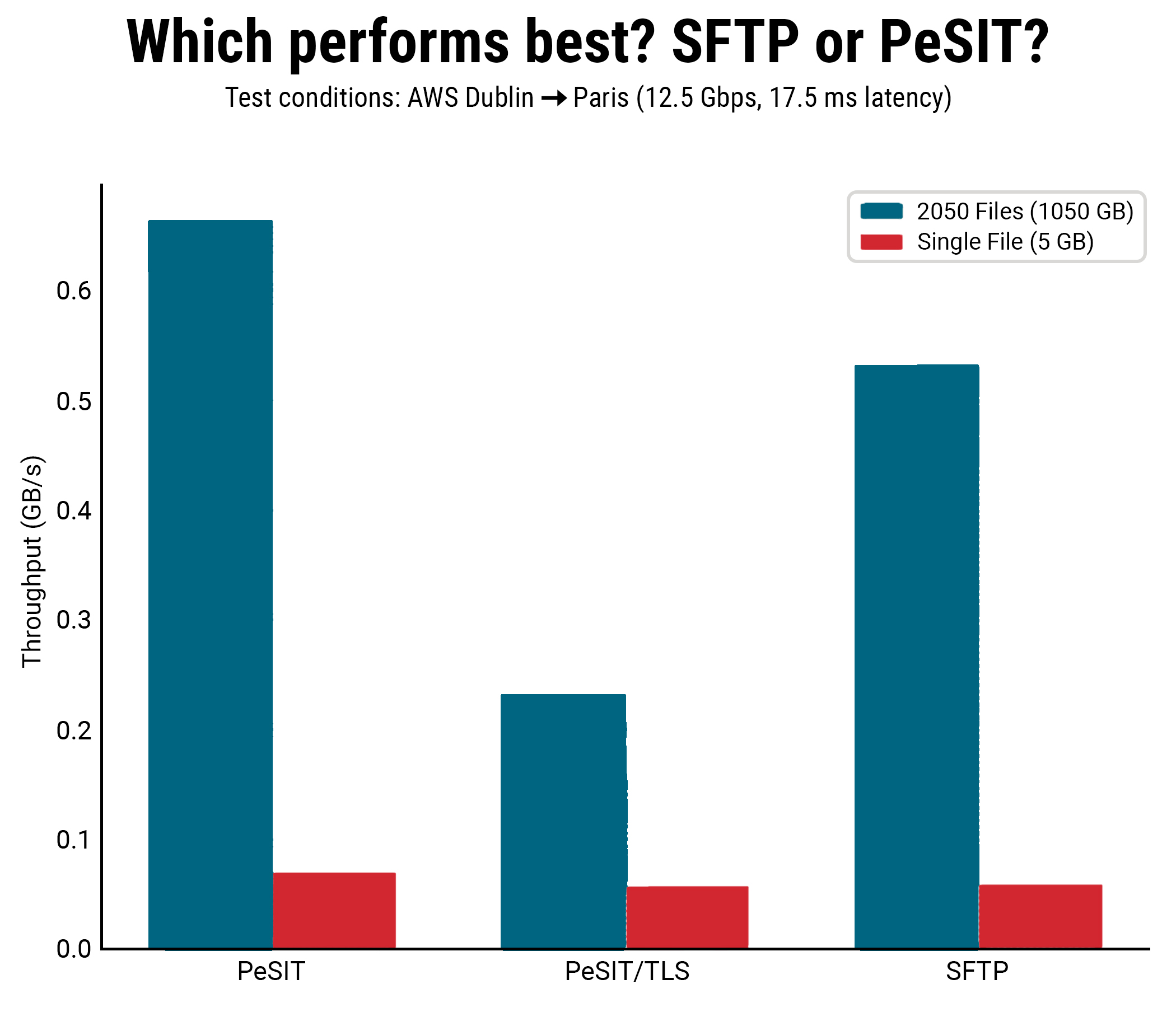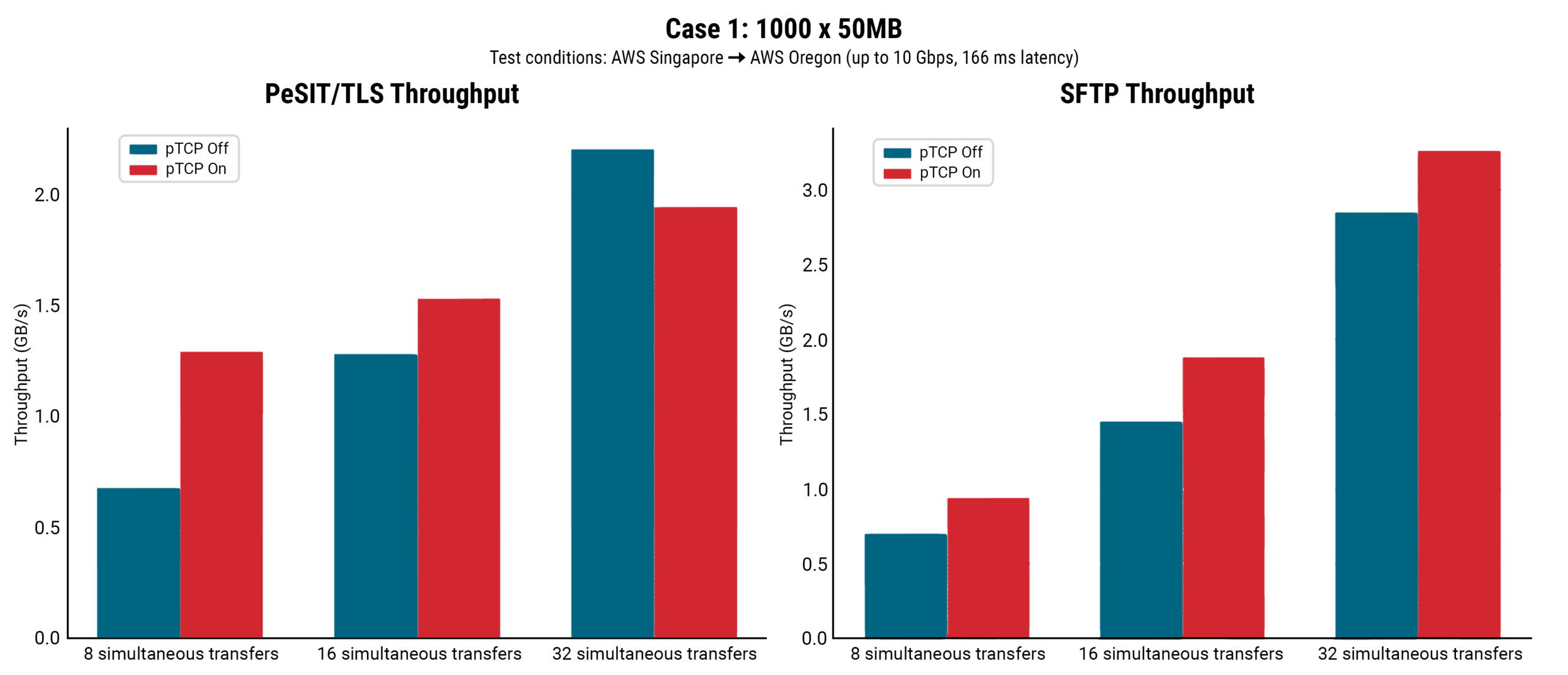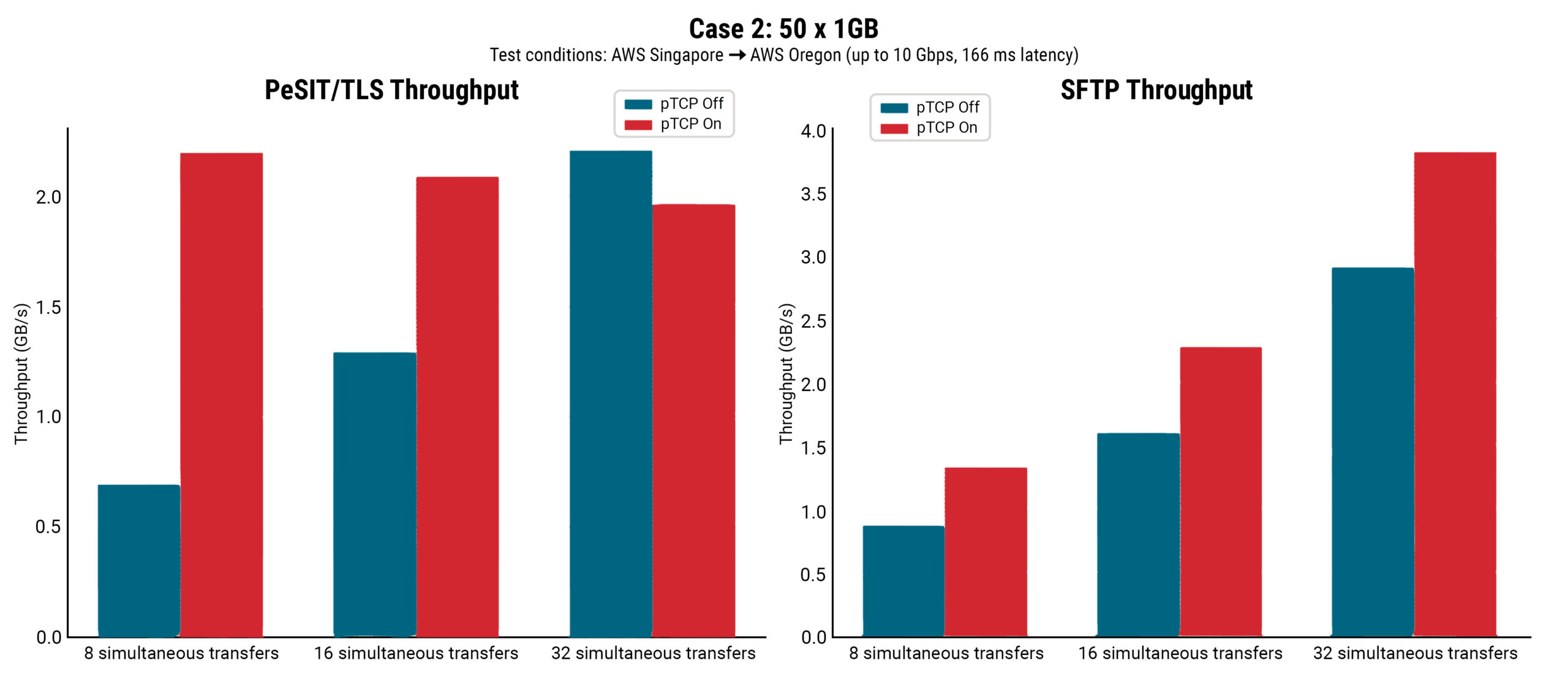In the world of managed file transfer, we often talk about the importance placed on reliability and how it relates to the rate of success of files arriving at their destination, but what about speed?
One train having delivered its freight to its destination at an average speed of 10mph versus another at 60mph can both be considered reliable in terms of meeting the core objective. However, so long as it arrives consistently, the fastest train can be used to scale the freight network by delivering more and enabling increased downstream activity.
In industries where data movement is mission-critical, large file and high-volume transfers play a pivotal role. For example, in the film industry, high-resolution content must be securely and swiftly distributed to theaters to ensure flawless releases. In aerospace, organizations rely on massive telemetry and satellite imagery transfers for real-time operations and scientific missions. And in financial institutions, exchange regulatory and transactional data at scale, demanding uncompromising security and compliance.
Across these sectors, the speed, reliability, and integrity of large file transfers directly impact business continuity and performance.
In this blog, we will explore what impacts the speed of file transfers, which protocols perform best, and how capabilities in Transfer CFT can push transfer speeds beyond what is available in competitor solutions.
Why speed matters in file transfer?
File transfer speed is more than a technical metric, it’s a business-critical factor. A slower transfer can mean:
- Overnight batch jobs running into the business day, delaying downstream processes.
- Missed regulatory deadlines in industries like banking or healthcare, leading to fines.
- Higher cloud costs, as resources are tied up longer.
- Poor customer and trading partner experience if transactions or updates are delayed.
In short, file transfer speed is about “time to value”.
Why protocol choice matters: PeSIT vs SFTP
In my experience, SFTP is the most prolifically used protocol for file transfers globally. It is simple, secure, and widely supported. But when the file counts or distances grow, some of its strengths become limiting:
- Latency sensitivity: Small packets and sequential acknowledgments slow SFTP down.
- Scaling challenges: SFTP often requires increasing concurrency just to reach acceptable throughput.
- CPU overhead: Encryption and session management reduce efficiency.
By contrast, PeSIT (and PeSIT over TLS) was designed specifically for high-performance file transfers between enterprise systems, offering:
- Optimized block transfer model for bulk throughput.
- Reliable, auditable delivery with sync points.
- TLS support for strong encryption and compliance.
For these reasons, PeSIT often performs better than SFTP in real-world, enterprise-scale workloads. This, of course, isn’t a rallying cry for the use of PeSIT, but does explain the results below.
Which performs best? SFTP or PeSIT?
Test conditions: AWS Dublin → Paris (12.5 Gbps, 17.5 ms latency)
We tested Transfer CFT across AWS Dublin and Paris, reading from EBS volumes and delivering into S3 buckets. This scenario mirrors many enterprise environments where regional data centers need to exchange large amounts of data.

Case 1: 2,050 files (total 1,050GB)
| Protocol | Duration (s) | Throughput (MB/s) | Notes |
| 🥇PeSIT | 1553 | 679 | Fastest overall, PeSIT’s block transfer model excels in multi-file workloads. |
| 🥉PeSIT/TLS | 2412 | 237 | TLS overhead cut throughput by ~65%; CPU/cipher likely limiting factor. |
| 🥈SFTP | 1938 | 544 | Outperformed PeSIT/TLS; consistent with SFTP benchmarks showing competitiveness with many smaller files when tuned. |
Case 2: a single 5GB file
| Protocol | Duration (s) | Throughput (MB/s) | Notes |
| 🥇PeSIT | 70 | 71 | Lead shrinks on single-file workloads; windowing limits efficiency. |
| 🥉PeSIT/TLS | 85 | 58 | TLS overhead more modest (~18% slowdown). |
| 🥈SFTP | 82 | 60 | Nearly identical to PeSIT/TLS, confirming that SFTP handles single large files more efficiently relative to its multi-file weakness. |
Conclusions
The benchmarks prove one thing clearly: Transfer CFT is fast, really fast.
- In multi-file workloads, PeSIT delivers enterprise-grade performance, completing jobs significantly faster than baseline SFTP.
- With TLS enabled, Transfer CFT still provides secure and predictable performance, balancing compliance with speed.
- For single large files, Transfer CFT performs on par with SFTP.
And, with parallel TCP acceleration (pTCP), Transfer CFT unlocks performance even across intercontinental, high-latency links — cutting transfer times by more than half in some cases.
Understanding the impact of pTCP on transfers
Test conditions: AWS Singapore → AWS Oregon (up to 10 Gbps, 166 ms latency)
In my experience, when transfers span oceans, latency becomes the main bottleneck. Even with plenty of bandwidth, a transfer cannot fill the pipe because of the bandwidth-delay product (BDP).
Let’s now see how Transfer CFT solves this with parallel TCP (pTCP), which opens multiple TCP connections for a single session, making much better use of available capacity.
Case 1: 1,000 files of 50MB each

| Protocol | Simultaneous Transfers | pTCP disabled (Duration / Throughput) | pTCP enabled (Duration / Throughput) | Throughput Acceleration Impact |
| PeSIT TLS | 8 | 581s / 0.69Gbps | 307s / 1.30Gbps | 🟢+88.4% |
| PeSIT TLS | 16 | 309s / 1.29Gbps | 259s / 1.54Gbps | 🟢+19.4% |
| PeSIT TLS | 32 | 181s / 2.21Gbps | 206s / 1.95Gbps | 🔴–11.8% |
| SFTP | 8 | 571s / 0.70Gbps | 426s / 0.94Gbps | 🟢 +34.3% |
| SFTP | 16 | 276s / 1.45Gbps | 213s / 1.88Gbps | 🟢 +29.7% |
| SFTP | 32 | 140s / 2.85Gbps | 111s / 3.62Gbps | 🟢 +27% |
In this test, without pTCP, both PeSIT/TLS and SFTP plateaued below 1 GB/s at 8 simultaneous transfers. With pTCP enabled, PeSIT/TLS nearly doubled throughput at 8 simultaneous transfers (0.69 → 1.3 GB/s). SFTP also improved, scaling up to 3.26 GB/s at 32 simultaneous transfers.
The practical impact? A 50 GB workload that would take almost 10 minutes could be cut to just 4 minutes — a tangible advantage for time-sensitive batch processes.
Case 2: 50 files of 1GB each

| Protocol | Simultaneous Transfers | pTCP disabled (Duration / Throughput) | pTCP enabled (Duration / Throughput) | Throughput Acceleration Impact |
| PeSIT TLS | 8 | 501s / 0.69Gbps | 182s / 2.20Gbps | 🟢+218.8% |
| PeSIT TLS | 16 | 282s / 1.29Gbps | 191s / 2.09Gbps | 🟢+62% |
| PeSIT TLS | 32 | 190s / 2.21Gbps | 205s / 1.96Gbps | 🔴-11.3% |
| SFTP | 8 | 461s / 0.87Gbps | 302s / 1.32Gbps | 🟢+51.7% |
| SFTP | 16 | 252s / 1.59Gbps | 176s / 2.27Gbps | 🟢+42.8% |
| SFTP | 32 | 138s / 2.90Gbps | 105s / 3.81Gbps | 🟢 31.4% |
This test shows the result of pTCP with fewer, larger files. At 8 simultaneous transfers, PeSIT/TLS throughput more than tripled (0.69 → 2.09 GB/s), cutting transfer time from over 8 minutes to under 3. SFTP also saw major improvements at 16 simultaneous transfers, more than doubling throughput (1.59 → 3.81 GB/s).
At very high concurrency (32 simultaneous transfers), PeSIT/TLS regressed in throughput due to overhead, reinforcing that the sweet spot for pTCP is typically 8–16 simultaneous transfers.
The business benefit? Large database copies or backups that once consumed an entire change window can now be completed in a fraction of the time.
What this means for your business
These results demonstrate that Transfer CFT isn’t just fast in the lab, it’s fast in the scenarios enterprises care about:
- Multi-file workloads (payments, logs, reconciliations): PeSIT consistently outperforms SFTP, finishing jobs minutes faster.
- Single large files (reports, exports, backups): All protocols converge, but CFT still edges ahead.
- Long-haul transfers (cross-continent replication): Parallel TCP provides 2–3× faster delivery at realistic concurrency levels.
Faster transfers mean:
- Meeting SLAs with confidence.
- Reducing infrastructure and cloud costs by completing jobs quicker.
- Freeing up bandwidth for other business-critical workloads.
- Feeding LLMs (large language models) with new and updated data quickly.
Why Transfer CFT outpaces competitors?
If you’re relying on generic SFTP servers or legacy MFT tools, you’re almost certainly leaving performance on the table. Competitors like MOVEit, Globalscape, or IBM Sterling don’t provide the protocol choice and acceleration features built into Transfer CFT.
However, it’s important to note that Transfer CFT is not the same type of product as UDP-based acceleration tools like FileCatalyst or Signiant. Those solutions are designed primarily for large media file distribution across the public Internet, using proprietary UDP protocols to bypass TCP’s limitations.
Transfer CFT, by contrast, is built for enterprise-grade internal and B2B file transfers — moving data reliably between applications, servers, and cloud environments.
It uses open protocols (PeSIT, SFTP) and optimises transfers over TCP, which means:
- Seamless integration into existing IT ecosystems.
- No tie into proprietary technologies.
- Wide-spread and historical knowledge available in the general marketplace.
Frequently Asked Questions (FAQ)
How does Transfer CFT improve file transfer performance?
Transfer CFT is designed for enterprise-scale workloads, supporting both PeSIT and SFTP protocols. By optimizing how files are packaged and transferred, and with features like parallel TCP acceleration, it ensures higher throughput and faster delivery across both local and global networks. This makes file transfers more efficient without requiring customers to abandon familiar protocols like SFTP.
What is the difference between PeSIT and SFTP?
PeSIT is an open protocol designed for high-performance, reliable file transfers in enterprise and banking environments. It uses optimized block transfer and sync points for throughput and auditability. SFTP, by contrast, is a widely supported secure protocol that ensures interoperability but may be less efficient for high-volume or high-latency transfers.
How does parallel TCP (pTCP) acceleration improve file transfer speed?
Parallel TCP (pTCP) opens multiple TCP streams simultaneously, overcoming the bandwidth-delay limitations of a single transfer. In our benchmarks, pTCP improved throughput by up to 200% on high-latency links, cutting transfer times from minutes to seconds.
Is Transfer CFT comparable to file acceleration tools like Connect:Direct, Aspera, FileCatalyst, or Signiant?
Not directly. FileCatalyst, Aspera and Signiant use proprietary UDP-based protocols optimized for large media file transfers over the public internet. Transfer CFT is built on open, TCP-based protocols (PeSIT, SFTP) and is designed for internal enterprise transfers, application integration, and ground-to-cloud use cases — where governance, security, and interoperability are critical.
Why should enterprises choose Transfer CFT for managed file transfer speed?
Enterprises need more than raw speed — they need reliability, compliance, and visibility. Transfer CFT not only delivers faster throughput with PeSIT and pTCP acceleration but also provides enterprise-class features like centralized monitoring, auditing, SLA tracking, and cloud integration. This combination of speed and governance makes it ideal for mission-critical file exchanges.
Explore how Transfer CFT transforms secure file exchanges beyond speed optimization.


